Las Palmas is a beautiful city in Gran Canaria, part of the Spanish Canary Islands. It is known for its beautiful palm-lined beaches and stunning scenery, but one of the greatest attractions of Las Palmas is the rich variety of birdlife found in the area.
With its warm climate, abundant vegetation, and wide range of habitats, Las Palmas is the perfect place for a wide variety of bird species, from the Eurasian Kestrel to the endangered Egyptian Vulture.
The city is home to a diverse range of species, including raptors, wading birds, seabirds, and many more, making it a great destination for bird-watchers and nature lovers alike.
1. Common Moorhen
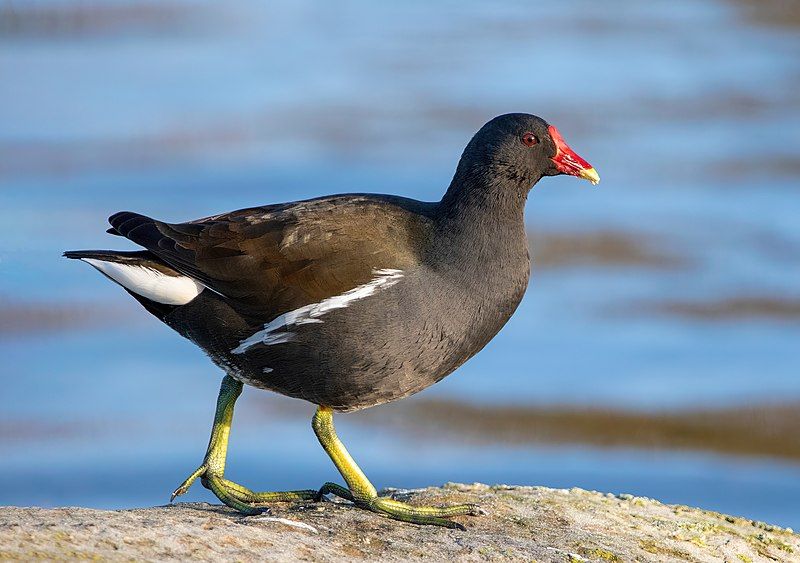
The Common Moorhen (Gallinula Chloropus) is an aquatic bird found in many parts of the Old World. It is also known by a variety of other names, such as Waterhen, Marsh Hen, and Swamp Chicken.
These birds are members of the rail family and have a unique black-and-white plumage pattern with a yellow bill and red frontal shield. The Common Moorhen is an adaptable species and can be found in a variety of habitats, including marshes, ponds, canals, and other wetlands.
These birds prefer areas that are well-vegetated, providing plenty of cover and access to food. They are generally found around the edges of water bodies, where they feed on aquatic invertebrates, aquatic plants, and small fish.
In addition to their diet of aquatic life, they will sometimes eat seeds, buds, and fruits from terrestrial plants. Common Moorhens are social birds and usually live in large colonies, often forming mixed flocks with other species such as Coots and Grebes.
In these colonies, they build floating nests made from vegetation, which are often found in densely vegetated areas.
They are also known to use nesting boxes set up near water bodies. The Common Moorhen is an important species in many wetland habitats, as they help to control aquatic invertebrate populations and disperse seeds from terrestrial plants.
They are also a popular species for birdwatchers, as they are relatively easy to observe and photograph.
| Kingdom | Animalia |
| Phylum | Chordata |
| Class | Aves |
| Order | Gruiformes |
| Family | Rallidae |
| Genus | Gallinula |
| Species | G. chloropus |
2. Common Pochard
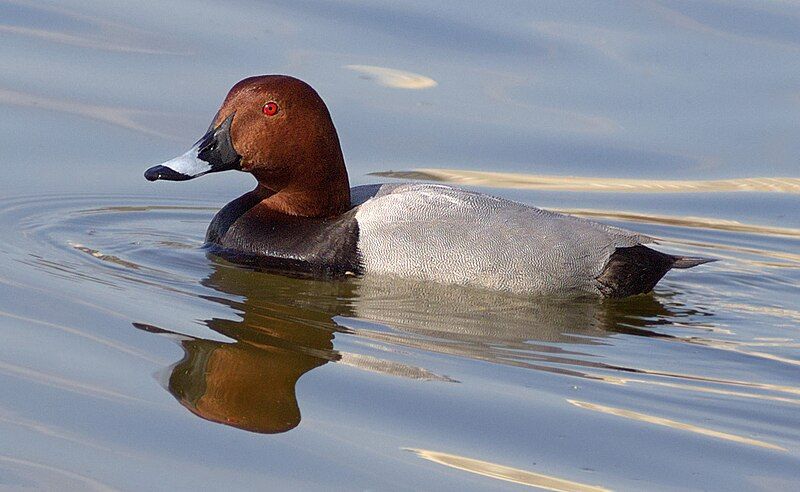
The common pochard is a medium-sized diving duck that is mostly found in Europe and Asia. Its scientific name, Aythya ferina, is derived from two languages, Greek and Latin.
The Greek word aithuia is an unidentified seabird mentioned by several authors including Hesychius and Aristotle, while the Latin word ferina means “wild game”, which comes from ferus meaning “wild”.
This name, therefore, indicates that this species is a wild game bird living in the wild. The common pochard is a migratory species, nesting in the north and wintering in the south.
It feeds mainly on aquatic invertebrates such as snails, mollusks, and crustaceans, as well as some plant material. Its body is mainly greyish-brown, with a white patch on the back of the neck.
It has a distinctive white patch on the lower face, which can easily be seen when the bird is in flight. Its head and neck are black, while the other parts of its body are brown. Its beak is long and pointed, and its feet are webbed.
The common pochard is an important species of bird as it is a keystone species in its ecosystem, playing an important role in maintaining the balance of the aquatic community.
It is an important source of food for predators such as raptors, foxes, and other animals, and its presence in wetlands is essential for maintaining biodiversity. It is also important for its recreational value, as it is a popular bird for birdwatchers and photographers.
The common pochard is currently listed as Least Concern by the IUCN, however, its population is decreasing due to habitat loss and disturbance. For this reason, conservation efforts need to be implemented in order to protect this species and its vital role in its ecosystem.
| Kingdom | Animalia |
| Phylum | Chordata |
| Class | Aves |
| Order | Anseriformes |
| Family | Anatidae |
| Genus | Aythya |
| Species | A. ferina |
3. Greater Flamingo
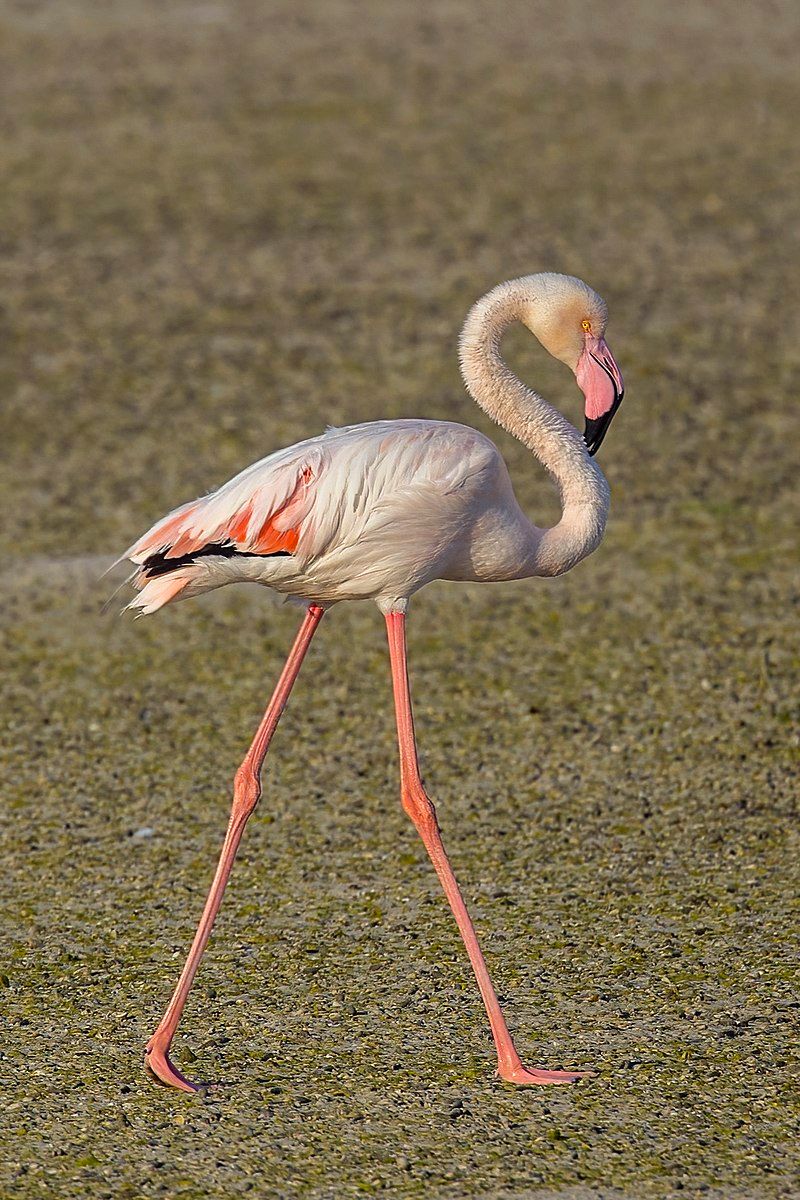
The greater flamingo is the most widespread and largest species in the flamingo family. It is a type of waterbird that can be found in a variety of locations around the world.
In the Old World, it is most common in Africa, with significant populations in Northern and Sub-Saharan Africa.
Additionally, greater flamingos also populate the Indian Subcontinent, the Middle East, the Levant, the Persian Gulf, the Gulf of Aden, the Red Sea, and the Mediterranean countries of Southern Europe. The greater flamingo is a large bird, standing up to five feet tall and weighing up to eight pounds.
It has a unique pink coloration that comes from the carotenoid pigments found in the crustaceans and plankton they eat. This species lives near shallow lakes, lagoons, and mudflats, and feeds mostly on small aquatic organisms.
They are also highly sociable birds, congregating in large flocks of up to thousands of individuals. The greater flamingo is an important species, serving as an indicator of the health of its environment.
It is listed as a species of Least Concern by the International Union for Conservation of Nature and is legally protected in some countries. However, habitat loss and pollution are still major threats to this species, and it is important to work to protect it and its habitat.
| Kingdom | Animalia |
| Phylum | Chordata |
| Class | Aves |
| Order | Phoenicopteriformes |
| Family | Phoenicopteridae |
| Genus | Phoenicopterus |
| Species | P. roseus |
4. Laurel Pigeon
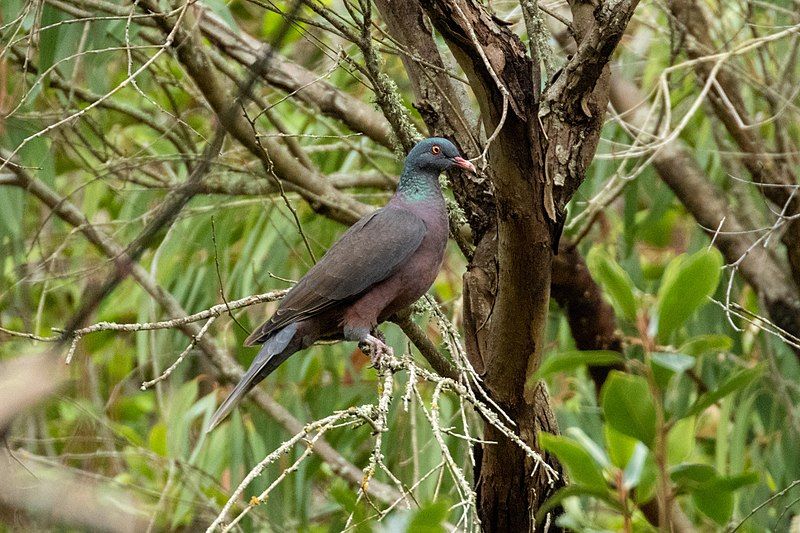
The laurel pigeon is a species of bird that is classified under the Columba genus in the Columbidae family. It is an endemic species, which means it is only found in the Canary Islands, Spain.
The laurel pigeon is a forest-dwelling bird and prefers to reside in laurel forest habitats. This species of bird has been adopted as the animal symbol of La Gomera, an island in the Canary Islands.
It is also known as the white-tailed laurel pigeon due to its distinctive white tail feathers. The laurel pigeon is a fairly small bird, measuring around 28-30 cm in length and having a wingspan of approximately 46-52 cm.
It has a predominantly light gray plumage, with black and white markings on the wings and tail. The laurel pigeon feeds mainly on fruits, berries, seeds, and leaves. In addition, it occasionally eats insects and other small invertebrates.
The laurel pigeon is a monogamous species and typically mates for life. They typically nest in tree cavities or on rocky ledges and lay two white eggs which are incubated by both parents.
The laurel pigeon is listed as a near-threatened species by the International Union for Conservation of Nature due to habitat loss and other threats.
| Kingdom | Animalia |
| Phylum | Chordata |
| Class | Aves |
| Order | Columbiformes |
| Family | Columbidae |
| Genus | Columba |
| Species | C. junoniae |
5. Bolle’s Pigeon
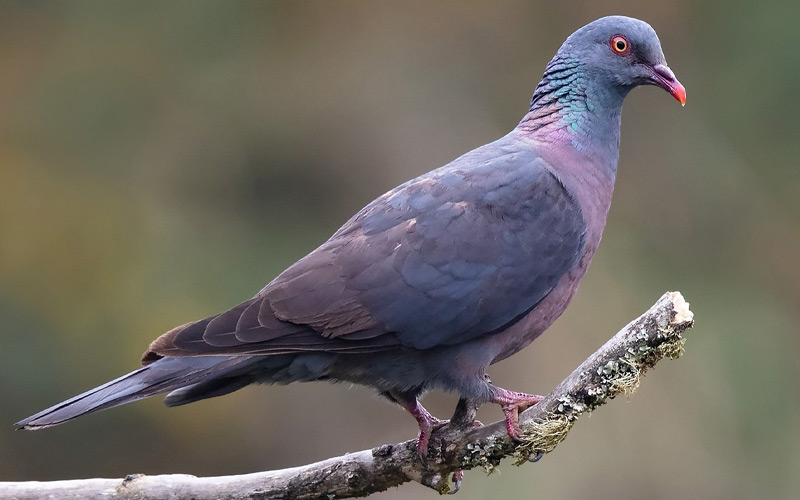
Source: ebird.org
Bolle’s pigeon is a species of bird that belongs to the family Columbidae, which is comprised of doves and pigeons. It is only found in the Canary Islands, a Spanish archipelago in the Atlantic Ocean.
It is also known as Bolle’s laurel pigeon or dark-tailed laurel pigeon, due to its distinctive dark tail feathers that set it apart from other species of pigeons.
The species was named after Carl Bolle, a German naturalist who was the first to identify it as a distinct species from the laurel pigeon. Bolle’s pigeon is a medium-sized bird with a light grey head and a brownish-grey body and wings.
Its tail feathers are dark brown, giving it its distinctive appearance. The species is considered to be a vulnerable species due to its declining population, largely caused by the destruction of its natural habitat.
| Kingdom | Animalia |
| Phylum | Chordata |
| Class | Aves |
| Order | Columbiformes |
| Family | Columbidae |
| Genus | Columba |
| Species | C. bollii |
6. Black-winged Stilt
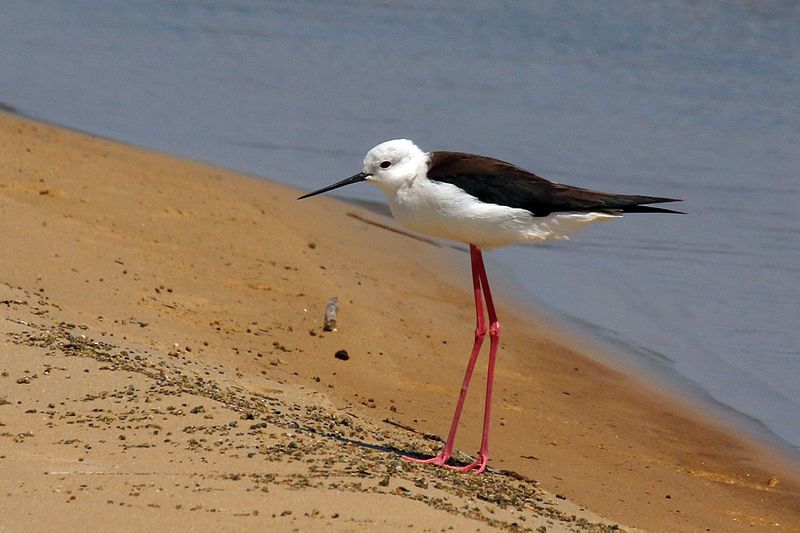
The Black-winged Stilt is a species of wader bird belonging to the family of avocets and stilts. It is widely distributed and is found in both tropical and temperate regions of the world. It is a large bird with long legs, and its scientific name is Himantopus himantopus.
It is sometimes referred to as a single species, although it is known to have two distinct subspecies, one found in Eurasia and the other in Africa and Australasia.
The Black-winged Stilt is the most common of all the stilts and avocets and is easily recognizable by its black wings, white back, and red legs. It prefers shallow, fresh, or brackish water and can be seen wading in marshes, shallow lakes, and estuaries.
It feeds on small fish, crustaceans, and aquatic insects, which it catches by quickly and repeatedly jabbing its long bill into the water. The Black-winged Stilt is a migratory species, and during the winter months, it can be found in Africa, India, and south-east Asia.
During the breeding season, it returns to Europe and northern Asia, where it nests in large colonies, often with other species of waders. It builds its nest on the ground in an open area, such as a field or marshland, and lays two to four eggs.
The adults take turns incubating the eggs, and the chicks are able to fly in about four weeks. The Black-winged Stilt is an important species for both its ecological and cultural importance.
It is a popular subject of birdwatching, and it is also an important indicator of water quality, as its presence or absence in a certain area can be an indication of the health of the local ecosystem.
| Kingdom | Animalia |
| Phylum | Chordata |
| Class | Aves |
| Order | Charadriiformes |
| Family | Recurvirostridae |
| Genus | Himantopus |
| Species | H. himantopus |
7. Sanderling
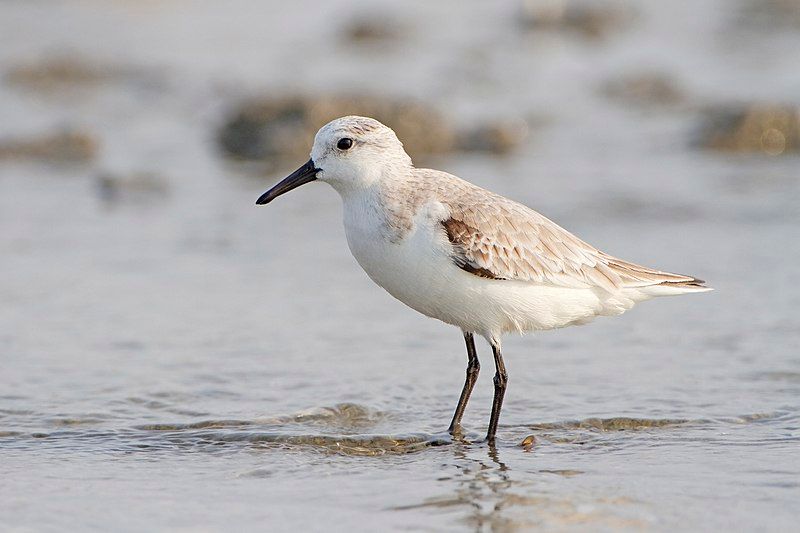
The sanderling is a small wading bird that is found in many parts of the world.
Its name is derived from Old English, specifically the term “sand-yrðling,” which translates to “sand-ploughman.” Its genus name, “kalidris” or “skalidris,” comes from Ancient Greek and was used by Aristotle to refer to a specific type of grey-colored waterside bird.
The specific name “alba” is Latin for “white.” The sanderling is a common wading bird, found in both fresh and saltwater habitats. They are usually found in large flocks and can be identified by their long legs and distinctive white bellies.
Sanderlings feed by running along the shoreline, picking up food as the water recedes. They are highly social birds and engage in complex courtship and mating rituals.
The sanderling has great ecological importance, as it helps to keep shorelines healthy by removing algae and other debris. They also provide food for other species, such as seabirds and marine mammals.
Sanderlings are an important part of the global food chain, and their presence is essential for the health of many ecosystems.
| Kingdom | Animalia |
| Phylum | Chordata |
| Class | Aves |
| Order | Charadriiformes |
| Family | Scolopacidae |
| Genus | Calidris |
| Species | C. alba |
8. Yellow-legged Gull
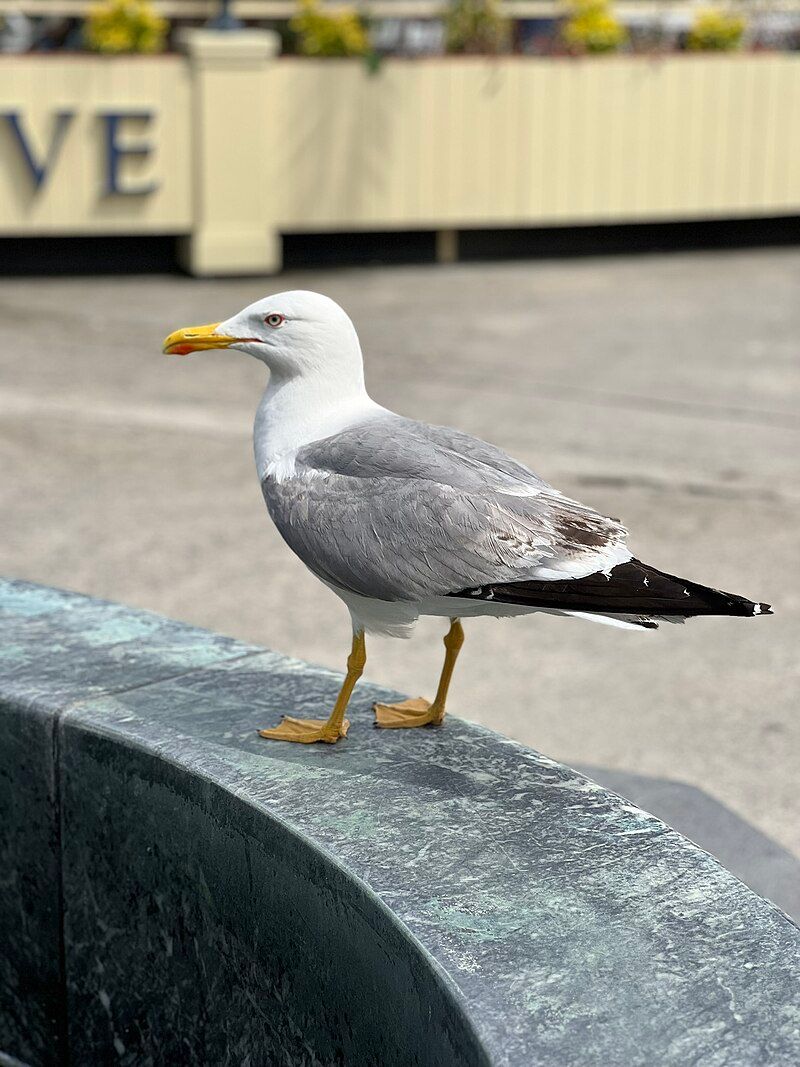
The yellow-legged gull (Larus michahellis) is a species of large gull found in Europe, the Middle East, and North Africa.
This species of gull has only recently gained recognition as a distinct species, as it was traditionally classified as a subspecies of either the Caspian gull (L. cachinnans) or more broadly as a subspecies of the herring gull (L. argentatus).
This species of gull is a large bird, with a wingspan of up to 1.6 meters, and can be identified by its yellow legs and feet, as well as its dark brown back and white underparts.
In addition, the yellow-legged gull has a black head, a yellow bill, and a black ring around its eyes. This species of gull is omnivorous and feeds on a variety of prey, including insects, fish, crustaceans, eggs, and carrion.
It also scavenges around human settlements for food. The yellow-legged gull is an important part of its ecosystem, as it helps keep the environment clean by eating carrion and helping disperse the seeds of aquatic plants.
| Kingdom | Animalia |
| Phylum | Chordata |
| Class | Aves |
| Order | Charadriiformes |
| Family | Laridae |
| Genus | Larus |
| Species | L. michahellis |
9. Cory’s Shearwater
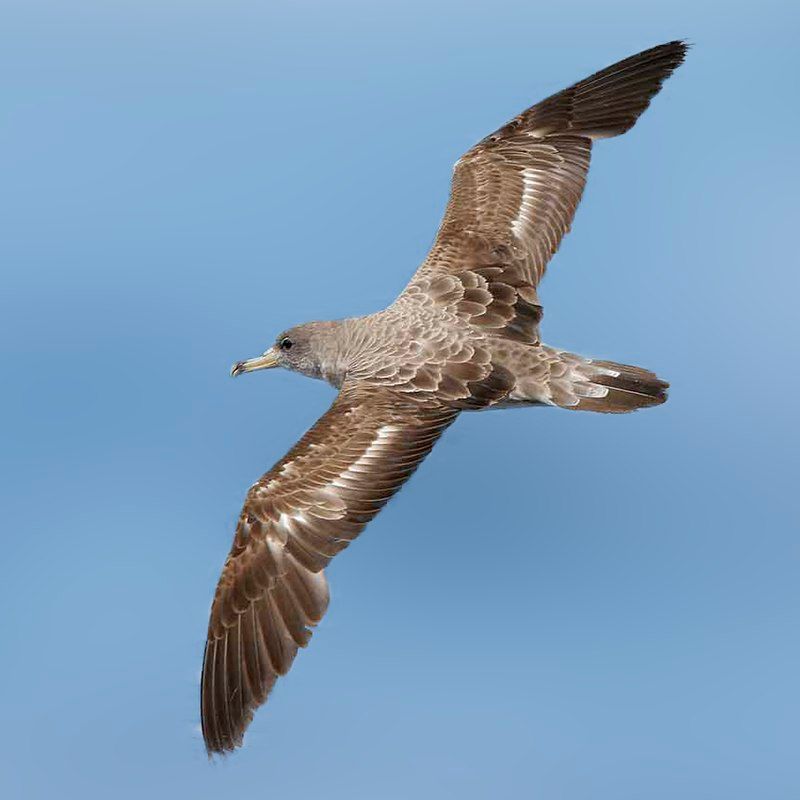
Cory’s shearwater is a species of seabird in the family Procellariidae. It breeds in colonies on rocky islands in the eastern Atlantic Ocean. When not breeding, it can be found in the Atlantic Ocean, ranging over a large area.
It was previously thought to be the same species as Scopoli’s shearwater. However, it has since been recognized as a distinct species. Cory’s shearwater is a large bird, with a wingspan of up to 82 cm (32 in). It has a black head, a white body, and a white tail with a black band.
Its diet consists of fish, squid, and crustaceans. It has a distinct call, described as a ‘harsh, laughing, mewing’. The bird is named after the American ornithologist Charles Barney Cory.
| Kingdom | Animalia |
| Phylum | Chordata |
| Class | Aves |
| Order | Procellariiformes |
| Family | Procellariidae |
| Genus | Calonectris |
| Species | C. borealis |
10. Little Egret
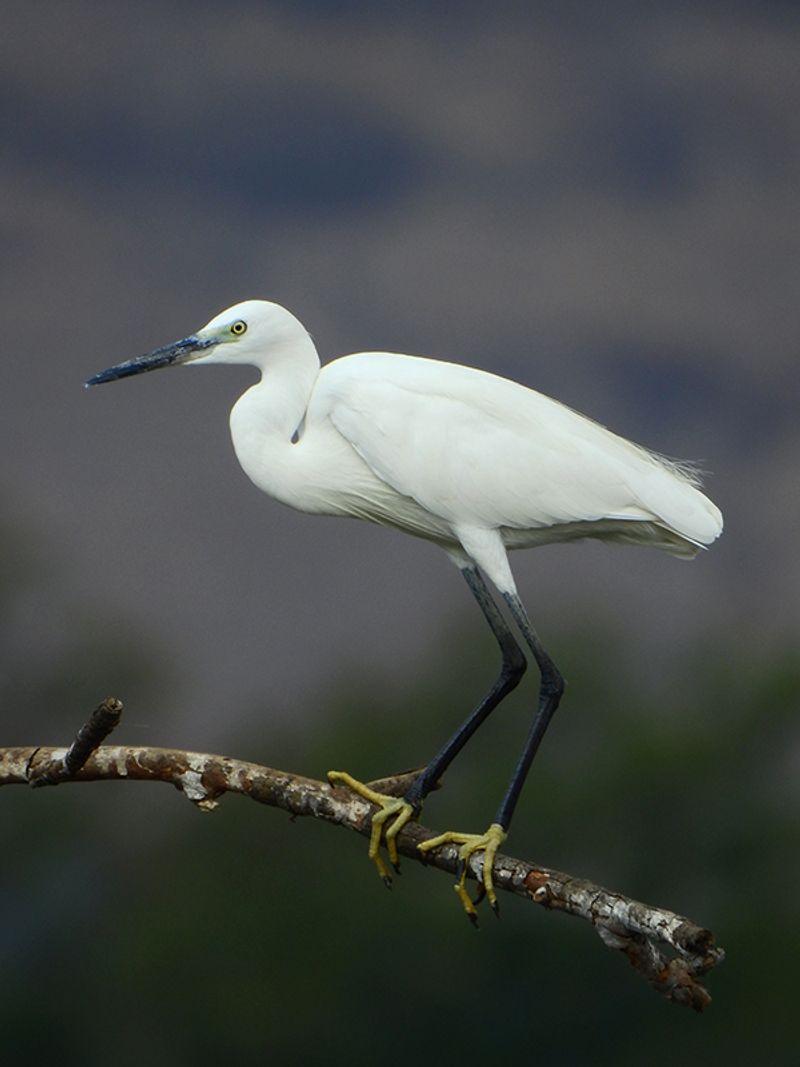
The Little Egret is a small heron that belongs to the Ardeidae family. It is a white bird that has a slender, black beak and long, black legs. The western race of Little Egret has yellow feet. This bird is an aquatic creature that feeds both in shallow water and on land.
It eats a variety of small creatures such as insects, crustaceans, and fish. The Little Egret is a graceful and elegant bird and is often seen wading in shallow waters, searching for food. It has a very distinctive call which is often heard in the early morning and evening.
It is one of the most commonly seen herons in wetlands and can be found all over the world.
| Kingdom | Animalia |
| Phylum | Chordata |
| Class | Aves |
| Order | Pelecaniformes |
| Family | Ardeidae |
| Genus | Egretta |
| Species | E. garzetta |
11. Little Ringed Plover
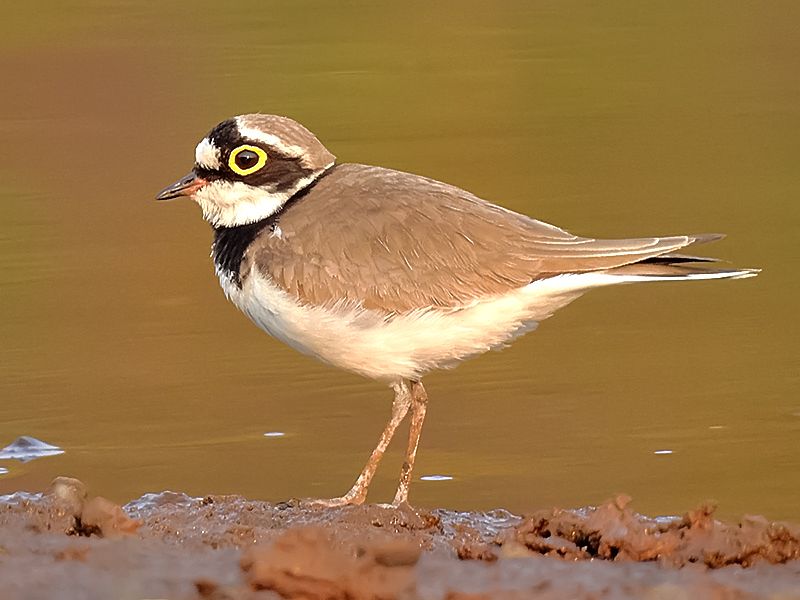
The little ringed plover is a small wading bird found in many parts of the world. Its scientific name, Charadrius, is derived from a Late Latin word that was used to describe a yellowish bird found in the fourth-century Vulgate.
This Latin word itself has its roots in the Ancient Greek kharadrios, which was the name given to a bird found in river valleys. This small plover is characterized by its small size and its distinctive yellowish-brown color.
It typically inhabits wetland habitats and feeds on insects, worms, and other small invertebrates. The little ringed plover is also known to migrate long distances, often traveling to warmer climates during the winter months.
This species is listed as vulnerable to extinction due to habitat loss and degradation, as well as hunting and other human activities. Conservation efforts are underway to help protect this species and its habitat.
| Kingdom | Animalia |
| Phylum | Chordata |
| Class | Aves |
| Order | Charadriiformes |
| Family | Charadriidae |
| Genus | Charadrius |
| Species | C. dubius |
12. Grey Heron
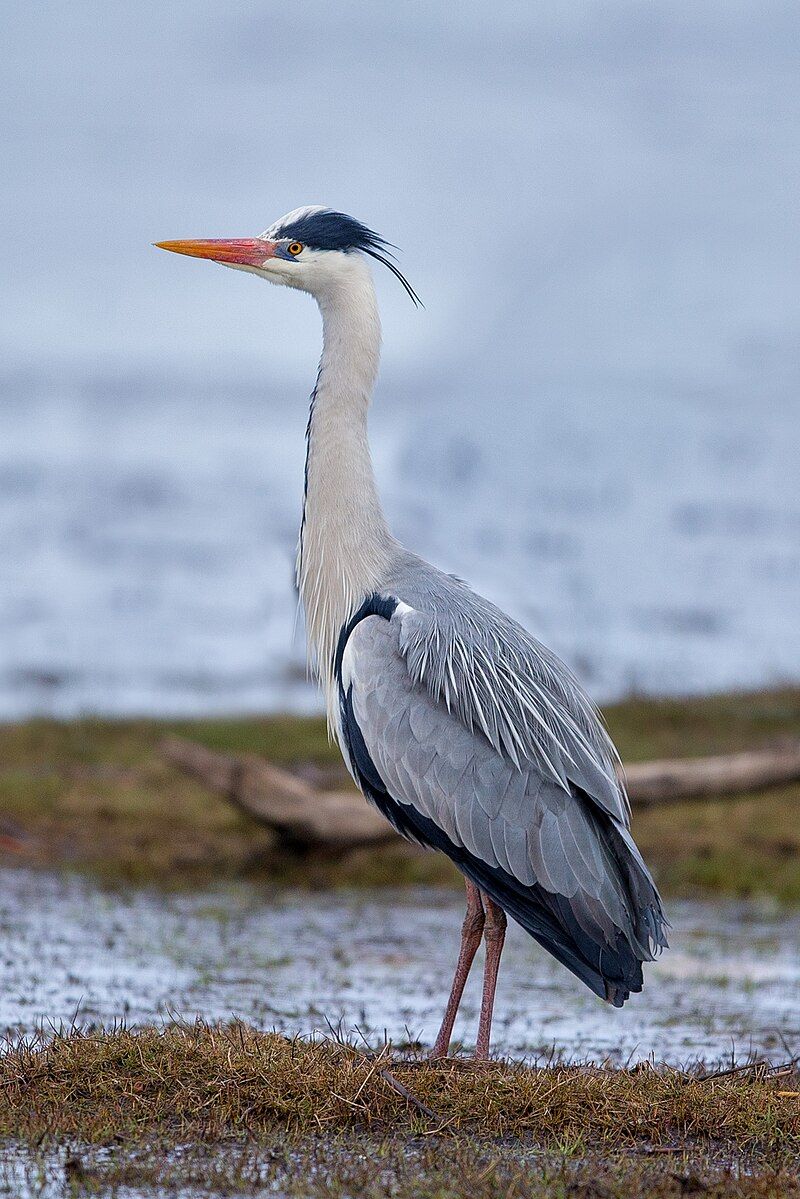
The Grey Heron is a species of wading bird belonging to the Ardeidae family. Native to temperate regions of Europe, Asia, and parts of Africa, it is a migratory species, with individuals from the northern parts of its range migrating south in the autumn.
It is a long-legged bird, typically standing at around one meter tall and possessing a wingspan of up to 2 meters. It is easily identifiable by its grey feathers, long neck, and pointed bill.
The Grey Heron is a relatively common bird and has adapted to living close to humans, often nesting in urban areas. It is an opportunistic feeder, consuming a wide variety of prey, including fish, amphibians, reptiles, small mammals, and insects.
It is generally solitary or found in pairs, but can form large flocks during migration.
| Kingdom | Animalia |
| Phylum | Chordata |
| Class | Aves |
| Order | Pelecaniformes |
| Family | Ardeidae |
| Genus | Ardea |
| Species | A. cinerea |
13. Canary
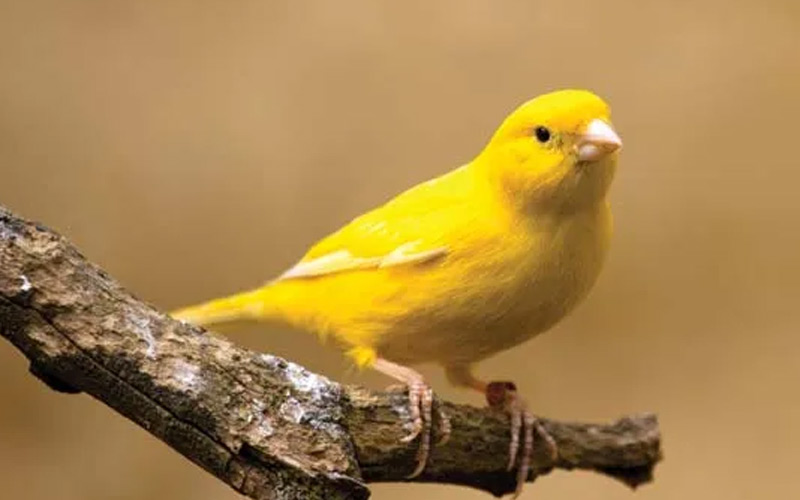
The domestic canary is a small, colorful songbird that has been kept as a pet for centuries. It is a domesticated form of the wild canary, which is a type of finch that is native to the Macaronesian Islands. The canary has a long history in captivity.
It was first bred in Europe in the 17th century, having been brought there by Spanish sailors. Canaries have since become popular pets, prized for their colorful plumage and melodious singing. They come in a variety of colors and patterns, including yellow, green, and white.
They also have distinctive songs, which can vary depending on the breed. Canaries are relatively easy to care for and require minimal space, making them great pets for those without a lot of room. They are social, active birds that enjoy the presence of their owners.
They have a fairly long lifespan of up to 15 years and can be taught to perform simple tricks. Canaries have a long history of use in the music industry. They were popular in classical music compositions and even featured in some operas.
They were also used in the recording studio to detect sound levels and were even incorporated into early versions of the synthesizer. Overall, the domestic canary is a charming and melodious pet that has been beloved by many for centuries.
Its attractive colors and captivating song make it a great companion for anyone looking for a small, low-maintenance bird.
| Kingdom | Animalia |
| Phylum | Chordata |
| Class | Aves |
| Order | Passeriformes |
| Family | Fringillidae |
| Genus | Serinus |
| Species | S. canaria |
14. Black-bellied Sandgrouse
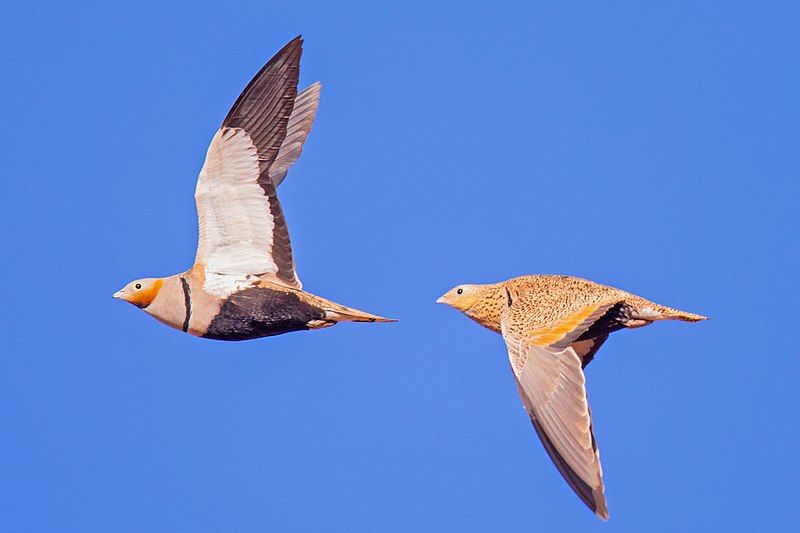
The black-bellied sandgrouse is a medium-sized bird belonging to the sandgrouse family. It is found in a variety of locations across the world, with the nominate race found in Iberia, northwest Africa, the Canary Islands, Turkey, Iran, Cyprus, and Israel.
Meanwhile, the eastern form of the bird, known as P. o. Irenaeus is found in Kazakhstan, western China, and northern Pakistan. These birds inhabit open arid habitats, such as dry steppes, semi-deserts, and deserts.
They are well-adapted to living in these conditions and have several unique characteristics that help them to survive in their environment.
For example, they have a thick coat of feathers to protect them from the intense heat, as well as a water-proof coating of wax to protect their feathers from the harsh desert winds.
They also have the ability to fly long distances in search of food, which is essential for their survival in such a harsh climate. These birds usually feed mainly on seeds, but they will also eat insects, berries, and other small animals.
As they forage for food in the desert, they will often drink from small pools of water to stay hydrated. The black-bellied sandgrouse is a unique species, and it plays an important role in the ecosystems of its habitats.
| Kingdom | Animalia |
| Phylum | Chordata |
| Class | Aves |
| Order | Pterocliformes |
| Family | Pteroclidae |
| Genus | Pterocles |
| Species | P. orientalis |
15. Lesser Flamingo
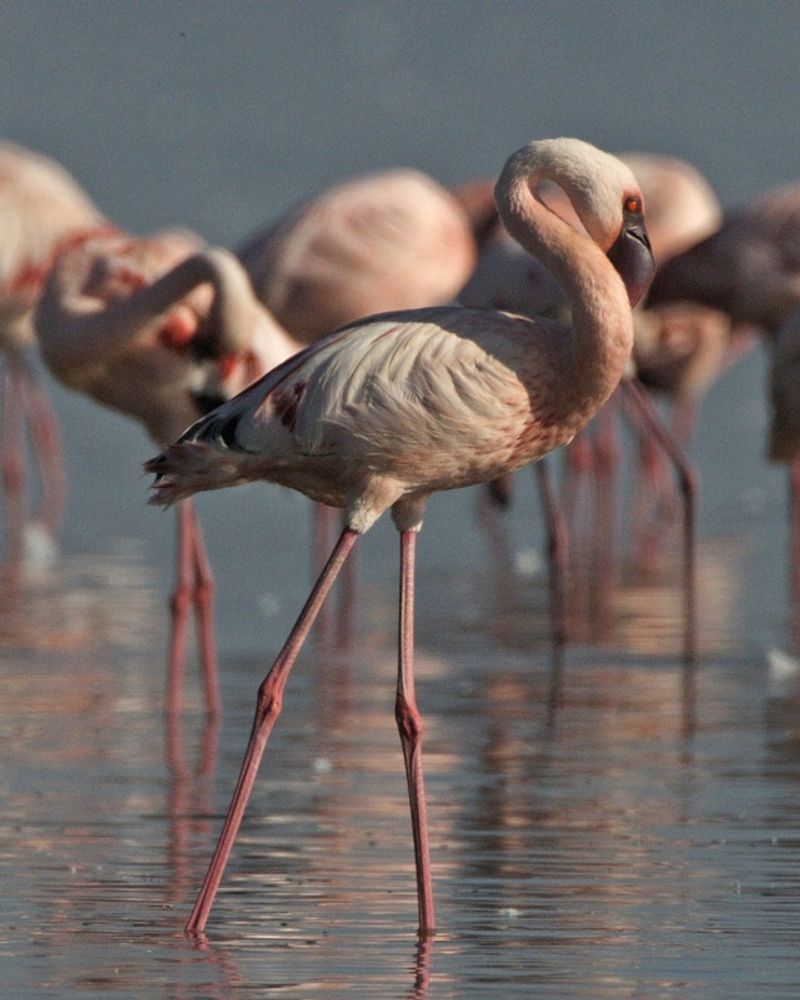
The lesser flamingo is a species of bird that can be found in sub-Saharan Africa and parts of western India. It is the most numerous of all flamingo species, and relatively common in its range.
Lesser flamingos are typically seen in large flocks, sometimes numbering in the thousands. They have distinctive pinkish-white plumage with black flight feathers and red legs.
They feed mainly on the microscopic algae found in shallow alkaline lakes and can filter up to an astonishing four gallons of water per hour.
Occasionally, lesser flamingos have been reported to be found further north of their usual range, in places such as Europe and North America. However, these sightings are usually thought to be of migrating birds or vagrants that have strayed away from their normal range.
| Kingdom | Animalia |
| Phylum | Chordata |
| Class | Aves |
| Order | Phoenicopteriformes |
| Family | Phoenicopteridae |
| Genus | Phoeniconaias |
| Species | P. minor |
16. Little Stint
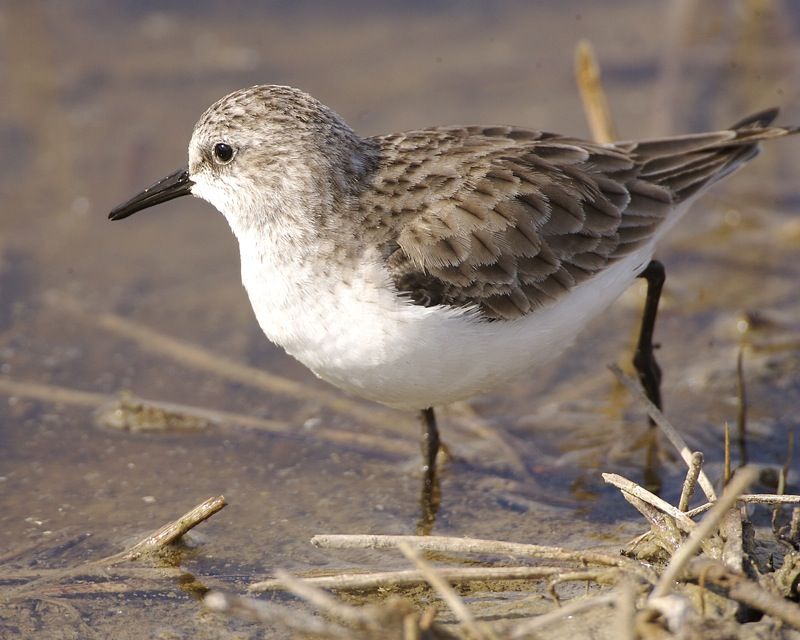
The little stint is an extremely small wader bird, native to the Arctic regions of Europe and Asia. It is a long-distance migratory species, making its way south to Africa and South Asia during the winter season.
It has been known to make rare and unexpected visits to North America and Australia. The little stint is a hardy species that is able to withstand the harsh temperatures of the Arctic environment during the breeding season.
They can also adjust to the changing climates of their winter homes. The little stint is a fascinating species that has been known to fly great distances in search of the perfect home.
| Kingdom | Animalia |
| Phylum | Chordata |
| Class | Aves |
| Order | Charadriiformes |
| Family | Scolopacidae |
| Genus | Calidris |
| Species | C. minuta |
17. Berthelot’s Pipit
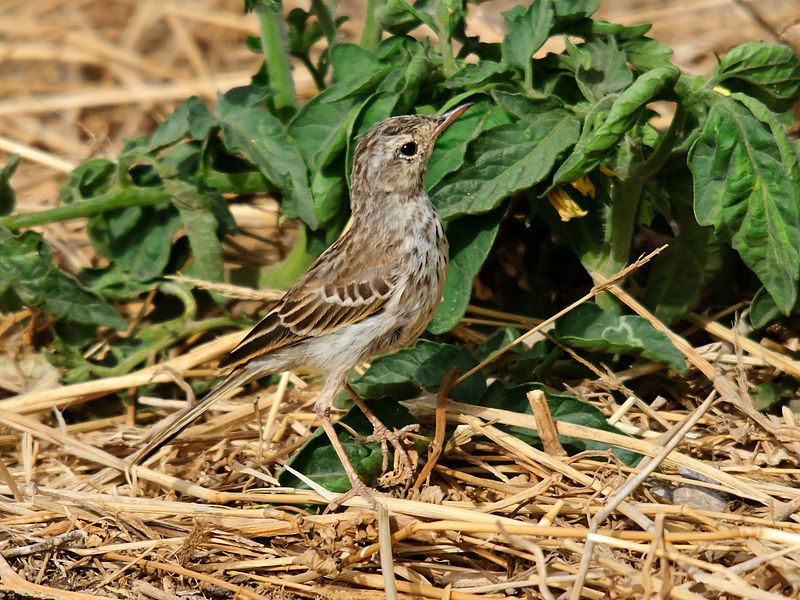
Berthelot’s pipit is a species of small passerine bird found in the islands of Madeira and the Canary Islands. It is a common resident in both archipelagos, living and breeding in the open countryside.
The nest of Berthelot’s pipit is built on the ground, and it typically lays between three to five eggs. This species of bird is relatively small, measuring between 13–14 centimeters in length.
It is thought to be closely related to the tree pipit and meadow pipit, two other species of small passerine birds found in Europe.
| Kingdom | Animalia |
| Phylum | Chordata |
| Class | Aves |
| Order | Passeriformes |
| Family | Motacillidae |
| Genus | Anthus |
| Species | A. berthelotii |
Conclusion
The birds of Las Palmas are a diverse and beautiful array of species that can be found in the city and its surrounding areas. They bring a lot of color and life to the city and provide a unique experience for both locals and visitors alike.
With a variety of habitats and places to explore, there is plenty to discover about the birds of Las Palmas. Whether you’re out for a leisurely stroll or a serious bird-watching expedition, there’s something for everyone to enjoy in the city.